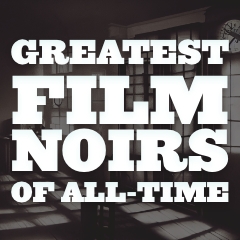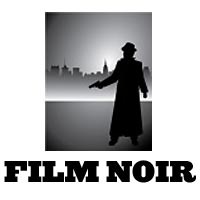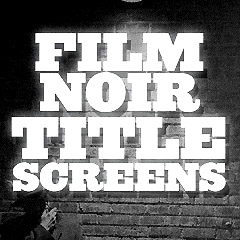|
 The
100+ Greatest Film Noirs of All-Time The
100+ Greatest Film Noirs of All-Time
Greatest Classic Film Noirs (1940-1958)
The term "Film noir" (literally 'black film"
or "black cinema') was coined by French film critics (first
by Nino Frank in 1946) who noticed the trend of how 'dark', downbeat
and black the looks and themes were of many American crime and
detective films released in France to theatres during and following
World War II. A wide range of films reflected the resultant tensions
and insecurities of the time period, and counter-balanced the
optimism of Hollywood's musicals and comedies.
Classic film noir developed during and
after World War II, taking advantage of the post-war ambience of anxiety,
pessimism, and suspicion. It was a style of low-cost, B-list American
films (the bottom of a double feature) that capitalized on advancements
in film-making in the 20s and 30s, including synchronized sound, panchromatic
(black and white) film stock with better light sensitivity, more compact
lighting equipment, and cheaper on-location shoots. Film
noir first evolved in the 1940s, became prominent in the post-war
era, and lasted in a classic "Golden Age" period until the
late 1950s.
Feelings of fear, mistrust,
bleakness, loss of innocence, despair and paranoia (displayed
through visual styling and low-key lighting) were readily evident
in noir, reflecting the 'chilly' Cold War period when the threat
of nuclear annihilation was ever-present. The criminal, violent,
misogynistic, hard-boiled, or greedy perspectives of anti-heroes
in film noir's story conventions were a metaphoric symptom of
society's evils, with a strong undercurrent of moral conflict,
purposelessness and sense of injustice. There were rarely happy
or optimistic endings in noirs.
Greatest Neo-Noirs or Post-Noirs (1958 and after)
Film noirs have recently been released in the modern era and have
been refashioned for present-day sensibilities. A number of them
in the 60s-70s were hard-boiled policeman-hero films that contained
film noirish characteristics. Most neo-noirs attempted to re-establish
the moods and themes of classic noirs. So-called post-noirs (modern tech-noirs, neo-noirs,
or cyberpunk) appeared after the classic period with an attempt
to revive the themes of classic noir, although they portrayed
contemporary times and were often filmed in color. Tech-noir (also
known as 'cyberpunk') refers specifically to a hybrid of high-tech
science-fiction and
film noirs portraying a decayed, grungy, unpromising, dark and
dystopic future - similar to what was found in the low-life, underworld
environments of hard-boiled 'pulp fiction' made popular by Raymond
Chandler and Dashiell Hammett.
|




